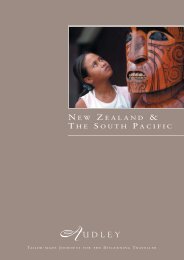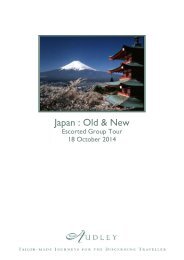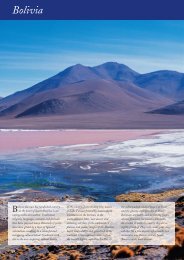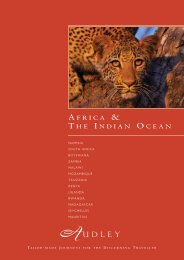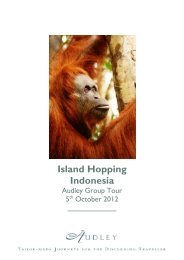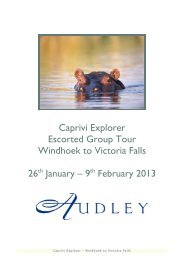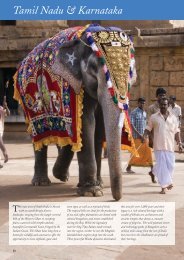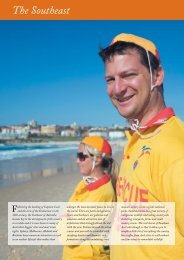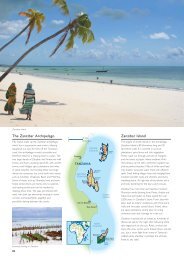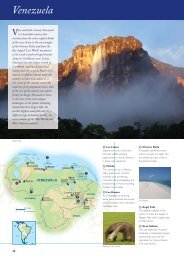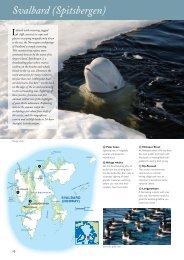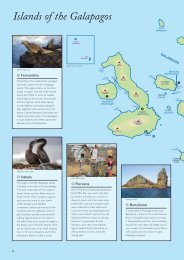01 Front Cover final.qxd:Audley brochure ... - Audley Travel
01 Front Cover final.qxd:Audley brochure ... - Audley Travel
01 Front Cover final.qxd:Audley brochure ... - Audley Travel
Create successful ePaper yourself
Turn your PDF publications into a flip-book with our unique Google optimized e-Paper software.
Chile<br />
Chilean legend has it that when God<br />
had finished creating earth, he walked<br />
back across the heavens and a little of<br />
everything that was left; mountains, deserts,<br />
lakes, glaciers, volcanoes and valleys, trickled<br />
out through a hole in his pocket, and thus<br />
Chile was born. So, this implausibly long,<br />
thin ribbon of land unfurls down the Pacific<br />
coast of South America and compresses an<br />
extraordinarily diverse range of terrain<br />
between its Andean spine on one side, and<br />
the ocean to the other. Sweeping from the<br />
world’s highest and driest desert down<br />
through rolling vineyards, past snow-dusted<br />
volcanoes, narrow fjords and turquoise lakes<br />
up to sharp granite peaks towering above<br />
blue icebergs, this slender slice of land is also<br />
bursting with culture and charm. Chileans<br />
are proud and friendly, fiercely protective<br />
of their traditions, and more than happy to<br />
enjoy a glass of the fiery national cocktail,<br />
pisco sour, with visitors. Add to all this the<br />
mysterious statues of Easter Island,<br />
marooned five hours’ flight away out in<br />
the Pacific Ocean, and you have every<br />
imaginable ingredient for a wealth of<br />
sights and experiences.<br />
100
<strong>Audley</strong> in Chile<br />
2<br />
1<br />
Moai, Easter Island<br />
1 Atacama Desert<br />
A stunning moonscape<br />
wilderness of volcanoes, salt<br />
lakes, multi-coloured lagoons,<br />
hot springs and geysers.<br />
2 Stargazing, Elqui Valley<br />
An area with incredibly clear<br />
night skies, with several<br />
international observatories<br />
that can be visited.<br />
3 Easter Island<br />
A tiny speck in the vast Pacific<br />
Ocean, a remote and mystical<br />
place, famous for the brooding<br />
stone statues that litter the<br />
volcanic landscape.<br />
The sheer size and diversity of Chile means<br />
it is something of a feat to cover all elements<br />
in one trip. Our specialist knowledge ensures<br />
that whatever your preference for sights and<br />
activities, we will strike the right balance for<br />
you to see as much as possible without<br />
spending too much time on the road or in<br />
the air. Due to the length of their shared<br />
border, Chile lends itself perfectly to a<br />
combined trip with Argentina. We can advise<br />
you about the many options for crossing<br />
from one to the other via the desert in the<br />
north, Santiago, the Lake District or<br />
Patagonia, all are remarkably beautiful<br />
journeys. As well as knowing the classic<br />
highlights of Chile in considerable depth, we<br />
pride ourselves on our knowledge of lesserknown<br />
regions and places to stay, and are<br />
more than happy to discuss specialist<br />
interests such as golf, wine, astronomy and<br />
skiing. Private excursions throughout a trip<br />
can prove to be rather expensive due to the<br />
size and remoteness of the country, so we<br />
can make use of small group tours to keep<br />
costs down if required.<br />
3<br />
4<br />
5<br />
6<br />
4 Vineyards and wineries<br />
The Colchagua Valley is the<br />
ideal place to start to learn<br />
about (and taste) some of the<br />
best wine in Chile.<br />
5 Lake District<br />
A pretty region of the bluest<br />
waters, white-tipped volcanoes,<br />
waterfalls and ancient forests,<br />
perfect for gentle hiking, bike<br />
riding, fishing or just relaxing.<br />
6 Aisén<br />
A beautiful and lush region<br />
with very few visitors, great for<br />
enjoying outdoor activities and<br />
stunning scenery.<br />
7 Torres del Paine<br />
Chile’s most beautiful<br />
national park, a magnificent<br />
place of towering granite<br />
peaks, turquoise lakes, condors<br />
and guanacos.<br />
Accommodation<br />
Hotels in Chile are as interestingly varied as<br />
the country’s distinct regions, and we always<br />
try to seek out character properties that<br />
reflect this. The country is home to the<br />
unique and outstanding Explora hotels, of<br />
which there are now three, and the Explora’s<br />
concept of high quality accommodation<br />
married to explorations of the surrounding<br />
landscape has inspired a plethora of similar<br />
properties, all of which are striving for the<br />
highest standards. Therefore Chile has some<br />
beautiful and unique hotels dotted<br />
throughout the country. There are also many<br />
equally charming, more simple properties,<br />
offering good value for money and high<br />
standards of service.<br />
Find out more<br />
7<br />
8<br />
8 Isla Navarino<br />
A small island located off the<br />
southernmost tip of the South<br />
American continent, for the<br />
ultimate in peace and quiet.<br />
Adventure cruising<br />
As befits a country with such<br />
a long and varied coastline,<br />
being on a boat can provide<br />
some wonderful sights and<br />
experiences.<br />
For suggested itineraries and practical<br />
information about travel in Chile, please see<br />
pages 114-115.<br />
☎<br />
www.audleytravel.com<br />
Interactive maps and features,<br />
further suggested itineraries,<br />
accommodation, climate information<br />
and articles written by our specialists.<br />
Discuss your plans with our Chile<br />
specialists <strong>01</strong>993 838 640<br />
Chile 1<strong>01</strong>
Santiago<br />
Santiago<br />
Snow-covered Andean peaks provide Santiago’s<br />
spectacular backdrop, but today they compete<br />
for dominance on the skyline with sparkling<br />
skyscrapers. The capital of Chile is a modern<br />
metropolis, but a charming one with many<br />
landscaped parks and peaceful hilltop sanctuaries<br />
offering calm amid the chaos. Wander the historic,<br />
civic heart of the downtown area and you’ll come<br />
across fine museums and churches, the impressive<br />
18th century government palace and the beautiful<br />
baroque cathedral. The modern and fast-paced<br />
commercial centre of Providencia is where you’ll<br />
find most of Santiago’s glitzy shops, restaurants<br />
and hotels. There is also the arty Bellavista district,<br />
from where the cable car ascends to the summit<br />
of San Cristóbal Hill, affording fantastic views<br />
over the city to the Andes.<br />
ACCOMMODATION IN SANTIAGO<br />
Unlike its neighbour’s capital city of Buenos Aires,<br />
the concept of boutique hotels has not fully<br />
caught on in Santiago. Good value yet characterful<br />
properties are not in abundance, instead what<br />
Santiago has to offer is a large number of high<br />
standard international chain hotels. For those<br />
seeking something more personal at a reasonable<br />
price we recommend the Hotel Orly, the<br />
Meridiano Sur and La Rêve, all of which are<br />
situated in the residential and commercial<br />
district of Providencia.<br />
102<br />
THE AUBREY, SANTIAGO<br />
The first luxury boutique hotel in Santiago, the<br />
Aubrey is situated at the foot of the San Cristóbal<br />
Hill within the Parque Metropolitano, one of the<br />
six largest urban parks in the world. Three years<br />
of careful restoration and renovation have<br />
transformed a historic house into a modern<br />
luxury boutique hotel with 15 rooms, all with<br />
their own character, and most with balconies or<br />
terraces. The outdoor patio terraces overlook<br />
exotic landscaped gardens, and there is a heated<br />
outdoor swimming pool.<br />
Virgin Mary on San Cristóbal Hill<br />
Meridiano Sur, Santiago<br />
Skiing<br />
During our summer months of June to<br />
September, the ski resorts nestling in the<br />
Andes (but handily within easy reach of<br />
Santiago) offer the largest number of<br />
runs in the southern hemisphere, Valle<br />
Nevado and Portillo being the most<br />
renowned. The spectacular views and<br />
superb standard of snow make Chile an<br />
increasingly popular destination for ski<br />
afficionados seeking action out of the<br />
northern hemisphere season. We can<br />
arrange stays in the resort hotels for any<br />
duration, complete with equipment hire<br />
(skis or snowboards) and lessons if<br />
required. It is also possible to have a<br />
day trip to the slopes from Santiago if<br />
time is short.
Valparaíso<br />
La Serena<br />
Valparaíso, Viña del Mar<br />
and Zapallar<br />
When you have explored the city of Santiago,<br />
you could head to the coast for a day, travelling<br />
through orchards and olive plantations to the<br />
fascinating seaside town of Valparaíso and its<br />
fancier neighbour of Viña del Mar.<br />
Tumbling precariously down dozens of hills to the<br />
port, Valparaíso is a maze of colourful buildings,<br />
boulevards and viewpoints, best explored using<br />
its ancient funicular railways and ‘elevators’. Here<br />
you can visit one of the homes of Chilean Nobel<br />
prize-winning poet Pablo Neruda, who was<br />
inspired by the town’s melting-pot charm and<br />
eccentricity. If you wish to stay overnight there<br />
are a couple of characterful properties, Casa<br />
Higueras and Hotel Zero. Viña del Mar, by<br />
contrast, is a genteel and fashionable resort that<br />
has been the weekend retreat of rich Santiago<br />
folk for generations.<br />
About two hours further north is the attractive<br />
and chic resort town of Zapallar. Set on a curved<br />
sandy bay and backed by lush forests this is a<br />
perfect place for a couple of relaxing nights.<br />
Elqui Valley<br />
La Serena and the Elqui Valley<br />
La Serena is a cheerful place, a mix of chic<br />
seafront and artistic old town, surrounded by a<br />
mystical and remote area of stunning scenery that<br />
climbs east into the Andes. Famed for having the<br />
clearest skies in the southern hemisphere, this<br />
blissfully tranquil area houses a large number of<br />
observatories, and attracts spiritualists as well as<br />
astronomers due to its reputedly unusual<br />
magnetic quality. Observatory visits can be<br />
arranged for those with an interest in the night<br />
skies. Tiny and impossibly picturesque villages –<br />
Montegrande, Vicuña, Pisco Elqui – dot the<br />
valley’s cultivated slopes and it is in these that<br />
Nobel prize winner Gabriela Mistral lived and<br />
taught. This is also the heart of pisco grape<br />
growing country and a trip here wouldn’t be<br />
complete without a distillery visit and tasting.<br />
Star gazing<br />
The north of Chile is renowned for its<br />
exceptionally clear night skies, and<br />
these atmospheric conditions, along<br />
with a lack of light pollution and high<br />
altitude, mean that the country is a<br />
world leader in astronomy. The scientific<br />
observation of the universe is<br />
undertaken in several internationallyfunded<br />
observatories around La Serena<br />
and further north in the Atacama<br />
Desert. There is currently further<br />
investment scheduled including the<br />
arrival of the world’s largest telescope,<br />
and the biggest ground-based<br />
astronomical project in the world,<br />
ALMA (Atacama Large Millimeter<br />
Array), which will be open to visitors.<br />
The starry skies in Chile can be<br />
explored by professionals and amateurs<br />
alike, as several of the observatories<br />
are open for tours. Typically over 300<br />
nights a year are suitable for stargazing<br />
and sky photography, so visitors to<br />
observatories such as La Silla, El Tololo,<br />
El Pangue and Cerro Mamalluca should<br />
be able to enjoy unlocking the secrets<br />
of the universe!<br />
Zapallar<br />
www.audleytravel.com/chile ● <strong>01</strong>993 838 640 ● Chile 103
Traditional winery, Colchagua Valley<br />
Wine Regions of<br />
Central Chile<br />
Surrounding Santiago to the north, south and<br />
west lie some of the New World’s finest<br />
vineyards. The most visited areas lie to the south<br />
of the city where the beautiful Maipo and<br />
Colchagua Valleys take most of the glory. These<br />
valleys can be visited either as a day trip from the<br />
capital or in more depth if you opt to stay at one<br />
or more of the wineries. Either option allows you<br />
the opportunity to explore either with a private<br />
guide or with your own car. This is a wonderful<br />
place to relax with stunning views through the<br />
green valleys up into the Andes.<br />
CASA SILVA, COLCHAGUA VALLEY<br />
The Casa Silva vineyard has a wonderful house<br />
dating back to the late 19th century and oozing<br />
with character. Along with the fine rooms<br />
decorated with traditional furniture you’ll find<br />
peaceful courtyards, a swimming pool and<br />
decorative fountains as well as a fantastic in-house<br />
restaurant and bar. In addition there is a rodeo<br />
and polo field, with stables housing up to fifty<br />
horses at any one time, offering you the chance<br />
to either relax or take part in a little activity if the<br />
mood strikes you.<br />
CASA LAPOSTOLLE,<br />
COLCHAGUA VALLEY<br />
Undoubtedly one of the best hotels in Chile, this<br />
tiny property on the Clos Apalta vineyard consists<br />
of just four private cabins on the steep hills of the<br />
Colchagua Valley. Each is incredibly spacious with<br />
an open fire and balconies overlooking the vines.<br />
As a perfect romantic getaway there are few<br />
places with such spectacular views accompanied<br />
by such great wine.<br />
old fashioned reading rooms or have a game on<br />
the full sized snooker table in the old smoking<br />
room, or simply unwind on the terrace which<br />
is dominated by a beautiful 150 year old<br />
bougainvillea.<br />
VIÑA MATETIC, ROSARIO VALLEY<br />
Nestled in the Rosario Valley between Santiago<br />
and Valparaíso and on the border of the more<br />
famous Casablanca Valley, Viña Matetic was once<br />
thought to be in the worst possible spot for wine<br />
production. How wrong those predictions were as<br />
their wines have become regular winners of major<br />
awards. The lodge offers fantastic service and a<br />
great mix of tradition and modern convenience.<br />
Vintage car, Colchagua Valley<br />
104<br />
CASA REAL, COLCHAGUA VALLEY<br />
Built around 1880 this old mansion was the<br />
showpiece home of the owners of the Santa Rita<br />
Estate and little expense was spared in creating a<br />
luxurious dwelling with manicured gardens and<br />
even their own family chapel. The house is now<br />
used as a small hotel with 16 spacious and stately<br />
bedrooms. You can also relax in the wonderfully<br />
Wine cellar
Chilean wine<br />
Owner's cellar, Casa Lapostolle<br />
On the land where the Andes meet the Pacific<br />
in a series of steep-sided valleys that flow<br />
down to ancient river beds and glacial paths,<br />
some of the best wines in the world are<br />
produced. Historically this region of Chile has<br />
been the fruit bowl of the country, but over<br />
the last couple of decades there has been a<br />
significant increase in money invested in what<br />
is now a flourishing wine industry. Chile has<br />
now become established in the top ten wine<br />
producers, by volume, in the world and many<br />
(professionals and amateurs alike) would put<br />
them in the top five for quality. It has not been<br />
an easy road to reach this status however. In<br />
the 1980s the quality was low and the climate<br />
and soil dismissed as too poor to produce high<br />
grade wines. But today, Chile is considered the<br />
perfect environment for a wide range of wine<br />
production; this is no longer a country that<br />
just produces a cheap merlot.<br />
These days Chile grows a wide variety of<br />
grapes, mostly red, from chocolaty carmeneres<br />
to robust cabernet sauvignons and wonderfully<br />
rounded merlots. In the Colchagua Valley you<br />
will find some of the best accommodation in<br />
the region such as the stunning Casa Lapostolle<br />
(on the Clos Apalta estate) and Casa Real<br />
(on the Santa Rita estate). For any wine lover<br />
this area is an essential part of a trip to Chile,<br />
Grapes, Colchagua Valley<br />
but if you are a serious connoisseur then you<br />
must get off the beaten track a little. <strong>Travel</strong>ling<br />
south from Colchagua you will find the Curico<br />
and Maule valleys and further south still you<br />
reach Itata and Bio Bio regions where many<br />
of the new wines that are on our shelves<br />
originate. Here you will find Casa Porta and<br />
their pinot noirs, and organic blends.<br />
However Chilean wine is not all about the<br />
reds. With fish featuring heavily in many<br />
Chilean diets, white wines are a natural<br />
complement, and the region west of Santiago<br />
specialises in this. In the rolling hills that work<br />
their way down from the mountains to the<br />
old port town of Valparaíso you will find the<br />
Casablanca and San Antonio Valleys, home to<br />
Viña Matetic. It is from here that the sauvignon<br />
blancs and an increasing number of<br />
chardonnays are produced. The environment<br />
here is a perfect blend of fresh sea air and<br />
mineral-rich soil left behind by millennia of<br />
seismic activity in the region.<br />
Whether you are something of a connoisseur<br />
looking to learn more about wine production<br />
or you simply appreciate great wine alongside<br />
lovely scenery and peaceful accommodation,<br />
then a few hours or days in this area will be<br />
time well spent. We can arrange trips that<br />
best suit your level of interest.<br />
Colchagua Valley vineyard<br />
www.audleytravel.com/chile ● <strong>01</strong>993 838 640 ● Chile 105
Atacama Desert<br />
The Far North<br />
The far north of Chile shares not only a border<br />
with Peru and Bolivia but also a common history<br />
derived from the pre-Conquest cultures of the<br />
region. The startling barren landscape holds a rich<br />
archaeological heritage – here you can discover<br />
immense geoglyphs, ancient cave art and excellent<br />
museums in and around the coastal towns of<br />
Arica and Iquique. To the east, this arid landscape,<br />
in shades of brown and gold, gives way to the<br />
foothills of the Andes and rises up to become<br />
part of the vast altiplano. Here panoramas of<br />
snow-topped volcanoes, herds of vicuña grazing<br />
amongst flowers and brightly coloured lakes await.<br />
Lauca National Park is visually stunning, and is<br />
en route for travellers who are taking the road<br />
from La Paz in Bolivia to Chile, via the equally<br />
sublime Sajama National Park.<br />
Cycling past Licancabur Volcano<br />
106<br />
Atacama Desert<br />
Eerie, austere, remote yet beautiful, never more<br />
so than at sunrise and sunset when the surfaces<br />
and the skies turn all manner of improbable hues<br />
of orange, crimson and gold, Chile’s Atacama<br />
Desert is so dry that there are many parts of it<br />
in which no rainfall has ever been recorded.<br />
This is an unlikely landscape to have a variety of<br />
attractions, yet the Atacama is a must-see for<br />
visitors to Chile, and the oasis town of San Pedro,<br />
at its heart, has some of the most original hotels<br />
in all of South America.<br />
After flying into Calama, a mining town with<br />
Chuquicamata, the largest open cast mine in the<br />
world in the hills behind it, travel by road through<br />
rolling swathes of parched lunar landscape to the<br />
welcoming town of San Pedro de Atacama, the<br />
base for explorations into the desert. From here<br />
you will join small guided groups, usually<br />
organised via your hotel, to marvel at the<br />
Atacama’s natural spectacles, and to discover<br />
archaeological sites; ancient mummies, geoglyphs,<br />
and crumbling ghost towns. Rise before dawn to<br />
drink your morning coffee at the world’s highest<br />
geothermal field, and watch the steam from your<br />
cup rise along with the spurting fumaroles of the<br />
Tatio geysers. Pick your way across the crunchy<br />
salt flats to spot the pink flamingos, photograph<br />
the vivid colours of the Miscanti and Meñique<br />
Lagoons, and climb the sweeping sand dunes of<br />
the Valley of the Moon to watch the sun set,<br />
turning them scarlet as it goes. This desert is an<br />
active person’s paradise, offering unique terrain<br />
through which to hike, cycle or horse ride, but it<br />
is also entirely accessible to those wishing to<br />
investigate it by vehicle, with the excellent hotel<br />
options offering total relaxation after an aweinspiring<br />
day’s exploration.<br />
Spotty llama, Atacama Desert
Vicuña, Atacama Desert<br />
Church, San Pedro de Atacama<br />
Flamingos in front of Licancabur Volcano<br />
ALTIPLANICO, SAN PEDRO<br />
DE ATACAMA<br />
Fifteen minutes walk from the centre of San<br />
Pedro lies a group of 16 adobe houses created<br />
out of local wood, mud, straw and stone, the<br />
typical building materials of the altiplano. This is<br />
the Altiplanico, which has real character and<br />
individuality and offers great value. Each of the<br />
houses are simply decorated, there is a lovely<br />
outdoor swimming pool and a relaxed café<br />
and bar.<br />
EXPLORA EN ATACAMA, SAN<br />
PEDRO DE ATACAMA<br />
The original pioneer of the concept of<br />
exclusive excursions combined with luxurious<br />
accommodation in San Pedro, the Explora en<br />
Atacama is the younger sister of the Patagonia<br />
property (see page 112). The hotel has awardwinning<br />
modern architecture, and its 50 guest<br />
rooms are large and well-furnished, and all have<br />
Jacuzzis. There are broad terraces for relaxing,<br />
plus a sculptured pool area, all with fine views<br />
over the nearby volcanoes. The property also<br />
has its own observatory with a powerful<br />
telescope for star gazing.<br />
Tierra Atacama, San Pedro de Atacama<br />
TIERRA ATACAMA, SAN PEDRO<br />
DE ATACAMA<br />
All of the 32 spacious rooms at the Tierra<br />
Atacama have private terraces and mountain<br />
views, some facing the mighty Licancabur Volcano.<br />
The communal dining rooms and terraces are<br />
warmed by fire pits and the cosy living rooms<br />
are the perfect place to spend the evening.<br />
Meanwhile, the spa is luxurious and offers a full<br />
range of treatments.<br />
AWASI, SAN PEDRO DE ATACAMA<br />
The Awasi is a beautiful retreat made up of only<br />
eight cottages, each having a private patio, reading<br />
sofa, and indoor and outdoor showers. Local<br />
materials have been crafted to create a unique,<br />
harmonious space designed for relaxation and<br />
rest. The Awasi is unique amongst the hotels in<br />
San Pedro in that it prepares private outings for<br />
its guests that are customised to ensure<br />
adventure and surprise.<br />
ALTO ATACAMA, NEAR<br />
SAN PEDRO DE ATACAMA<br />
The location of the Alto Atacama, in a valley<br />
surrounded by deep red mountains, gives the<br />
hotel a real feeling of serenity and remoteness,<br />
despite being just three kilometres from San Pedro<br />
de Atacama. As well as a luxurious spa and natural<br />
thermal pools, six small swimming pools are<br />
nestled in the landscaped gardens. The 32 rooms<br />
are warm and stylish, and the hotel also has its<br />
own observatory within the extensive grounds.<br />
OTHER ACCOMMODATION<br />
OPTIONS IN SAN PEDRO DE ATACAMA<br />
Other than the Altiplanico, options for those<br />
looking for properties that are not at the luxury<br />
end of the spectrum include the Aldea, Hosteria<br />
San Pedro de Atacama, Poblado Kimal and the<br />
Atacama Adventure Lodge. The rooms are simple,<br />
but most have a swimming pool and all have<br />
good levels of service.<br />
Alto Atacama, near San Pedro de Atacama<br />
www.audleytravel.com/chile ● <strong>01</strong>993 838 640 ● Chile 107
Osorno Volcano at sunrise<br />
The Lake District<br />
Chile’s Lake District starts in the north at<br />
Temuco and stretches over 300 kilometres south<br />
to Puerto Montt, where the gentle lakes end and<br />
the landscape changes into the harsher face of<br />
northern Patagonia. It is an impossibly pretty<br />
region of the bluest waters, white-tipped<br />
volcanoes, waterfalls and ancient forests. It is<br />
perfect for hiking, bike riding, fishing, relaxing in<br />
thermal pools, languorous cruises around fjords<br />
and glaciers, and the enjoyment of fresh air<br />
(although be prepared for some rain). You can<br />
either base yourself at one of the charming hotels<br />
and take daily excursions, or drive yourself around<br />
the region (see feature on page 111).<br />
Pucón and around<br />
Pucón is the popular and stylish epicentre of all<br />
activity in the northern lakes area. If you enjoy<br />
fishing, rafting, rambling, horse riding or would like<br />
to climb the slopes of the Villarica volcano, then<br />
this is the place for you. We can arrange car hire,<br />
or for our local guides to take you and a picnic<br />
out for the day by road, foot or boat, but if you<br />
prefer simply to relax and take in the views,<br />
there is no better place in which to do it.<br />
ANTUMALAL, NEAR PUCÓN<br />
Situated two kilometres outside Pucón, set in<br />
over five hectares of landscaped gardens and<br />
with its own private beach and dock, is the<br />
Antumalal hotel. Its low-slung 1950s design was<br />
very advanced for its time and provided the<br />
inspiration for the renowned Explora hotels in the<br />
Atacama and Patagonia. The hotel’s modern style<br />
is combined with cosy comfort and personalised<br />
service – the Pollak family have managed it since<br />
the beginning – and facilities include a heated<br />
outdoor swimming pool and tennis court.<br />
Excursions on foot, by boat or on horseback can<br />
be organised for you by the hotel’s exclusive<br />
guides. Each of the 16 rooms has a view of<br />
either Lake Villarrica or the gardens from their<br />
floor to ceiling windows, as do the restaurant,<br />
lounge and terrace.<br />
Puerto Varas and around<br />
The best place to base yourself to explore the<br />
southern lakes area is in or around the small town<br />
of Puerto Varas, with its enviable location on the<br />
shores of Lake Llanquihue. Famous for the roses<br />
which bloom all over the town from December<br />
to March, Puerto Varas is overlooked by the<br />
conical peaks of Osorno and Calbuco volcanoes<br />
and is a lovely place to unwind during your travels<br />
through Chile. Day trips can be arranged to<br />
Petrohue Falls and the national parks of Vicente<br />
Perez Rosales and Alerce Andino, the interesting<br />
settlements of Puerto Octay (its Germanic roots<br />
reflected in its Bavarian-style architecture) and<br />
the little lakeside resort of Frutillar, or Chiloé<br />
Island, a mysterious place of myth and legend.<br />
Those travelling into Argentina via the famous<br />
and picturesque ‘Lake Crossing’ will do so from<br />
Puerto Varas by bus and boat through the<br />
Andes in one or two days (with a stop<br />
overnight in Puella).<br />
CASA MOLINA, NEAR<br />
PUERTO VARAS<br />
Ten kilometres out of Puerto Varas, Casa Molino<br />
has a wonderful location on Lake Llanquihue, with<br />
stunning views to the nearby Osorno volcano.<br />
There are 11 rooms, some with fireplaces and<br />
Jacuzzis and all with views either to the lake or<br />
to the gardens.<br />
Church, Puerto Varas<br />
108
Local farmer, near Puerto Varas<br />
Puerto Varas and the Osorno Volcano<br />
Chiloé Island<br />
Flower sellers, Puerto Montt<br />
Forest and waterfall, Aisén<br />
QUINCHO COUNTRY HOME,<br />
NEAR PUERTO VARAS<br />
Overlooking Lake Llanquihue ten kilometres from<br />
Puerto Varas in the opposite direction to Casa<br />
Molino, Quincho Country Home is an incredibly<br />
welcoming home from home in the Chilean lakes.<br />
The house is beautifully designed and decorated,<br />
and with only four rooms, each guest is attended<br />
to with great care and attention to detail.<br />
Delicious home cooked food with fresh, local<br />
ingredients is combined with fine wine.<br />
Mapuche boy<br />
Quincho Country Home<br />
Aisén<br />
Chile’s Southern Highway, begun in 1976 under<br />
the determined project management of General<br />
Pinochet, snakes south from Puerto Montt<br />
through the country’s remote Aisén region down<br />
to southern Patagonia. The landscape through<br />
which you pass is dramatic, pristine, and enticingly<br />
studded with waterfalls, rivers, forests and lakes.<br />
The road’s romantic ending is a forced one; at the<br />
tiny hamlet of Villa O’Higgins it can go no further,<br />
obliged to trail off as the vast Southern Ice Field<br />
takes over. For those keen on road trips, we can<br />
organise a hire car and maps (see feature on<br />
page 111), or we can arrange a guide if you are<br />
heading for a specific attraction, maybe the towns<br />
of Cochrane or Coyhaique, the hanging glaciers of<br />
Queulat, or a cruise through the maze of fjords to<br />
the mighty glacier on Lake San Rafael. If you are<br />
short of time, you can fly into the town of<br />
Balmaceda, which allows easy access to the<br />
attractions of the region.<br />
ACCOMMODATION IN THE<br />
AISÉN REGION<br />
Scattered throughout this lush area are a number<br />
of rustic lodges which offer comfortable<br />
accommodation and a great range of outdoor<br />
activities, so that you can make the most of the<br />
mountains, glaciers, lakes and rivers. Mallín<br />
Colorado Ecolodge and Terra Luna are both<br />
situated on the shores of Lake General Carrera,<br />
both offer a warm welcome and a range of<br />
excursions by foot, horseback, bicycle or boat, plus<br />
fishing trips. Close by, the more luxurious Hacienda<br />
Tres Lagos also offers adventure activities and<br />
pampering. All can arrange excursions to the<br />
Northern Patagonian ice field. The Puyuhuapi<br />
Lodge & Spa is a more remote property only<br />
accessible by boat, a journey that provides<br />
stunning views of the dramatic fjord scenery.<br />
Icebergs from the San Rafael Glacier<br />
www.audleytravel.com/chile ● <strong>01</strong>993 838 640 ● Chile 109
Chile by water<br />
Skorpios II<br />
Chile’s unique ribbon-like shape gives it over<br />
4,300 kilometres of coastline stretching down<br />
the west coast of South America. The bottom<br />
third of this coastline is a fragmented landscape,<br />
as if this part of Chile was once dropped on the<br />
floor and it shattered into a thousand pieces.<br />
This means that there are many fjords, islets,<br />
archipelagos and peninsulas to explore, and<br />
there is no better (indeed there is no other)<br />
way to explore this fascinating territory than by<br />
taking to the water. This can be done either as<br />
a day trip, on a longer journey as a means of<br />
getting from place to place, or on a relaxing<br />
cruise as a key part of your Chile trip.<br />
NAVIMAG<br />
Navimag operate passenger ferries (carrying<br />
between 100 and 250 people) between Puerto<br />
Montt and Puerto Natales, a journey that is<br />
impossible to complete by road on the mainland<br />
due to the obstacle of the Southern Patagonia<br />
Ice Field. They also operate various other routes<br />
in the area which are ideal for travellers, locals<br />
and cargo alike. Joining the ferry offers you the<br />
unique chance to see the fjords and coastline<br />
of southern Chile go by at a leisurely pace,<br />
allowing you plenty of time to spot dolphins<br />
and whales along the way, as you wind your<br />
way through narrow channels and along the<br />
side of spectacular glaciers. The atmospheric<br />
journey takes three nights and leaves you at the<br />
gateway of Torres del Paine. Cabins are basic<br />
but food plentiful and community spirit abounds,<br />
with nightly gatherings to enjoy a pisco sour,<br />
Chile’s traditional drink.<br />
SKORPIOS<br />
The vessels Skorpios II and III follow three<br />
different routes through the channels and fjords<br />
of Chilean Patagonia on cruises lasting between<br />
three and five nights. The itineraries visit the<br />
fringes of either the Northern or Southern<br />
Patagonian Ice fields between Puerto Montt and<br />
Puerto Natales. The boats have a capacity of up<br />
to 130 passengers, with well-furnished, modern<br />
en suite cabins on a number of decks, and a<br />
good menu of local Chilean cuisine. Daily<br />
excursions by motor launch take you to explore<br />
the mainland, cruise through the dramatic<br />
icebergs, or up to the face of huge glaciers.<br />
NOCTILUCA<br />
A 20 metre motor yacht which can sail into<br />
places that the bigger boats cannot, the<br />
Noctiluca offers a unique and intimate sailing<br />
experience with personalised itineraries around<br />
the beautiful and remote Aisén region.<br />
Noctiluca was constructed on Chiloé Island<br />
from a unique Patagonian wood that has been<br />
used for centuries by the local mariners, and<br />
sleeps four to eight passengers. It has a<br />
comfortable lounge area, spacious outer decks<br />
and the food and wine is of the highest quality.<br />
A truly exclusive experience.<br />
CRUCEROS AUSTRALIS<br />
Finally, to the very tip of the continent. The<br />
Beagle Channel and Cape Horn (weather<br />
permitting!) are two of the highlights of the<br />
‘Cruceros Australis’ cruises that sail the waters<br />
between Punta Arenas in Chile and Ushuaia,<br />
on Tierra del Fuego in Argentina, on three and<br />
four night voyages. There are daily excursions<br />
to see glaciers, elephant seal and penguin<br />
colonies, plus lectures from the knowledgeable<br />
guides, as well as evening entertainment.<br />
Comfortable cabins and plentiful food and<br />
drink mean these trips are a fabulous way to<br />
experience some of the remotest parts of the<br />
continent in a little bit of comfort. The cruises<br />
operate from September to April, with<br />
occasional sailings in the winter months.<br />
Noctiluca<br />
110
Chile by road<br />
Typical road, northern Chile<br />
As well as the 4,300 kilometres of coastline,<br />
Chile’s unique geography also creates some<br />
wonderful opportunities for road travel, either<br />
with a driver on some of the more challenging<br />
terrain, or driving yourself. Independent selfdrive<br />
in South America as a whole is not always<br />
the easiest thing in the world, even for<br />
experienced independent travellers, because of<br />
undeveloped roads, a lack of ‘road etiquette’<br />
and sparse road signs. Chile, however, is an<br />
exception and offers fantastic opportunities to<br />
explore under your own steam. The romantic<br />
notion of driving from top to bottom of the<br />
country is actually an impossibility though, as<br />
the Southern Patagonia Ice Field bisects the<br />
country, and the roads cannot cross it.<br />
The North<br />
One of the most spectacular overland trips in<br />
the world is between southwestern Bolivia and<br />
Chile’s Atacama Desert. This is a trip where you<br />
definitely need to be a passenger and let an<br />
expert who knows the area do the driving, as<br />
much of it is off-road amongst the Salar de<br />
Uyuni salt flats (see page 30), volcanoes and<br />
colourful lagoons. The scenery is breathtaking,<br />
from seeing the curvature of the earth when<br />
standing on the dazzling white salt, to the<br />
descent into the oasis town of San Pedro de<br />
Atacama. The Explora hotel (see page 107)<br />
arranges a travesía (‘journey’) from its property<br />
in San Pedro up through this area, in incredibly<br />
luxurious style considering the remoteness of<br />
the terrain. There are also other less expensive<br />
options for those not staying at the Explora.<br />
These trips stay in simpler places with less<br />
creature comforts, but all use sturdy 4x4s, a<br />
pre requisite for the region.<br />
The Centre<br />
Driving yourself from Santiago down to the<br />
Chilean Lake District is a wonderfully relaxing<br />
few days along good roads, via some of the best<br />
wine-producing regions in the country. Once in<br />
the Lake District, you will find some of the best<br />
self-driving opportunities in South America, with<br />
good roads that skirt by emerald green lakes,<br />
wind around volcanoes and pass through small<br />
picturesque towns.<br />
To the north of the region you will find the<br />
town of Pucón nestled under the Villarrica<br />
Volcano and as you travel south from here you<br />
enter one of the most indigenous parts of Chile.<br />
The Huilo Huilo Nature Reserve lies on the<br />
other side of the volcano, and is full of ancient<br />
woodland, remote lakes and a deep sense of<br />
history and tradition rooted in the Mapuche<br />
Indian past. Driving south you enter a region<br />
that was heavily populated by German<br />
immigrants in the 19th century. This is the most<br />
commonly visited part of the region, focused<br />
around the town of Puerto Varas. Having a car<br />
here allows you the flexibility to explore the<br />
region at your own pace.<br />
Driving over into the Argentinian Lake District<br />
is possible, but one of the quirks of the hire car<br />
set up is that it can be prohibitively expensive to<br />
return a hire car to a different country, so we<br />
would recommend looping back into Chile.<br />
For the more adventurous there is the option<br />
of driving further south, down into the Aisén<br />
region. Mainly on unpaved roads, and with the<br />
need for some ferries, this can be a challenging<br />
trip, but it is through some of the most pristine<br />
areas of Chile, much of it national parks. There<br />
are lodges along the route, which becomes<br />
more rugged as you travel south. Finally, you can<br />
go no further, the road stops at the settlement<br />
of Villa O’Higgins as the Southern Patagonian Ice<br />
Field proves an impassable barrier.<br />
The South<br />
Below the Southern Patagonian Ice Field, roads<br />
start up again, and exploring this end of Chile by<br />
road is all about long journeys across wide open<br />
expanses of Patagonian steppe. Driving yourself<br />
around Torres del Paine National Park is an<br />
interesting way of seeing the magnificent scenery<br />
at your own pace, giving you a little more<br />
flexibility to explore on your own rather than<br />
being in a group.<br />
www.audleytravel.com/chile ● <strong>01</strong>993 838 640 ● Chile 111
Torres del Paine National Park<br />
Torres del Paine<br />
National Park<br />
The most famous national park in Chile and all<br />
of Patagonia, Torres del Paine is remote, rugged<br />
and windswept. While this makes it lengthy to<br />
reach and demanding to explore, its seclusion is<br />
the very essence of its appeal and it is undeniably<br />
worth the effort. Unless crossing into the park by<br />
road from Argentina via El Calafate, you will arrive<br />
by air into Punta Arenas; Chile’s southernmost<br />
city, a bustling place of multi-coloured houses<br />
that resonate with pioneer spirit. You may wish<br />
to stay a night here before or after your time in<br />
the park itself, in order to break up the long<br />
journey. To get into the park you will travel<br />
through the Patagonian steppe for 300 kilometres<br />
Explora en Patagonia<br />
112<br />
to Puerto Natales, and then on another 100<br />
kilometres to the park itself where your first<br />
sighting of the eponymous torres (towers) and<br />
the uniquely smooth and twisted cuernos (horns)<br />
of the Paine Massif will be unforgettable. Once<br />
there, the incredible landscape is waiting to be<br />
explored, either by foot, boat, bike, horse or<br />
vehicle. We particularly recommend an<br />
afternoon’s sailing on Lago Grey to approach the<br />
glacier of the same name, navigating through vivid<br />
blue icebergs on the way. However you choose<br />
to explore you will marvel at emerald and<br />
turquoise lakes, waterfalls and grazing guanacos.<br />
For those who fancy some trekking you can take<br />
a hard day’s hike to the base of the towers, or a<br />
longer circuit involving camping and up to six<br />
days’ walking.<br />
EXPLORA EN PATAGONIA,<br />
TORRES DEL PAINE<br />
Sister to the Atacama hotel, the Patagonian<br />
Explora may be wildly different in terms of setting,<br />
but its design, facilities and service are equally<br />
outstanding. All public areas and the Scandinavianstyle<br />
bedrooms have views of the lake, mountain<br />
range or the Salto Chico waterfall. Some rooms<br />
have Jacuzzis, but there are also open air pools,<br />
saunas and hot tubs. As in the Atacama, all your<br />
transportation, meals and excursions are included,<br />
and the expert guides will share with you their<br />
knowledge and love of Chile’s most famous<br />
national park.<br />
REMOTA, PUERTO NATALES<br />
An ultra-modern, environmentally-friendly building<br />
on the water’s edge to the north of Puerto<br />
Natales, Remota has comfortable and stylish<br />
rooms, and large public areas dominated by open<br />
fires with spectacular views of Seno Ultima<br />
Esperanza. The hotel aims to show visitors more<br />
of Chilean Patagonia than a traditional visit to<br />
Torres del Paine National Park may offer by<br />
organising trips outside of the main park areas.<br />
PATAGONIA CAMP, TORRES<br />
DEL PAINE<br />
Located on the shores of Lago Toro, an hour<br />
from Puerto Natales and an hour from the<br />
famous towers of Torres del Paine, Patagonia<br />
Camp accommodates its guests in ‘yurts’ or<br />
wooden tents with central heating and en suite<br />
facilities. Each yurt has fantastic views and a<br />
private balcony and a skylight in the roof so you<br />
can see the stars while you lie in bed.<br />
Patagonia Camp
Guanaco, Torres del Paine National Park<br />
Lago Gray, Torres del Paine National Park<br />
LODGE CERRO GUIDO, TORRES<br />
DEL PAINE<br />
This is a perfect place for keen horse riders to<br />
experience Patagonia and see parts of the<br />
national park that very few people are likely to<br />
experience. Located close to the Argentine<br />
border, and indeed feeling like something of an<br />
outpost, the lodge has seven comfortable<br />
rooms and a restaurant with stunning views<br />
across the park.<br />
OTHER ACCOMMODATION<br />
OPTIONS, TORRES DEL PAINE<br />
Aside from the accommodation mentioned<br />
above, which we have chosen for either the<br />
uniqueness of their setting or service, there are<br />
other choices that offer comfortable and cosy<br />
accommodation and are good bases from which<br />
to explore the area. Our recommendations<br />
include Hotel Las Torres, Hosteria Lago Grey<br />
(with its spectacular views over the lake and<br />
glacier of the same name), the small and<br />
welcoming Cabañas del Paine and Rio Serrano.<br />
Easter Island<br />
Out in the Pacific Ocean, a five hour flight west<br />
from the Chilean mainland, lies a tiny speck of<br />
volcanic rock. This is Easter Island, or Rapa Nui<br />
as it is known to the locals, a place that has<br />
fascinated traveller and scholars alike for centuries.<br />
This is due to the squat bodies and brooding<br />
Moai, Easter Island<br />
faces of hundreds of stone statues or ‘moai’<br />
that gaze from all corners of the island. A three<br />
or four night trip to this intriguing destination<br />
means coming face to face with these moai,<br />
admiring their form and size and pondering the<br />
mysteries of why and how they were erected.<br />
The population centres on the small town of<br />
Hanga Roa in the southwest of the island, from<br />
where you can explore the island with a guide,<br />
or independently, and by hire car, foot or on<br />
horseback, depending on your preferences<br />
and budget.<br />
ACCOMMODATION ON<br />
EASTER ISLAND<br />
There are a range of accommodation options<br />
on Easter Island. The most luxurious choice is the<br />
youngest of the Explora properties, Explora Rapa<br />
Nui. Set on a hill that faces the sea in the south<br />
west of the island, five kilometres from the town<br />
of Hanga Roa. Volcanic rock from the island and<br />
wood from the mainland have been used in the<br />
construction of the property, which has 30 guest<br />
rooms branching off from the living and dining<br />
areas. There’s also a bar, massage salon and an<br />
open-air pool. The Hanga Roa Eco Village & Spa<br />
is another luxurious option, whilst cheaper<br />
properties include the Iorana, Otai and Gomero.<br />
These hotels are without luxurious trimmings, but<br />
are friendly and relaxed properties, all located in<br />
and around Hanga Roa.<br />
Explora Rapa Nui<br />
Isla Navarino<br />
The island of Isla Navarino lies at the far<br />
southern tip of Chile, a place that throughout<br />
history has been a safe haven for countless ships,<br />
limping in to gather strength for, or recover<br />
from, sailing around Cape Horn. Today’s visitors<br />
are more likely to be adventurous travellers<br />
looking for somewhere utterly remote to trek<br />
and spot wildlife, and have a drink in the world’s<br />
most southerly pub in Puerto Williams, the<br />
world’s most southerly permanent settlement<br />
(outside of Antarctica). Isla Navarino is reached<br />
by a short flight (or long ferry trip) from Punta<br />
Arenas, and accommodation is at Lakutaia, a<br />
rustic but comfortable lodge from where you<br />
can explore the very end of the world.<br />
www.audleytravel.com/chile ● <strong>01</strong>993 838 640 ● Chile 113
Calama<br />
Santiago<br />
CHILE<br />
ARGENTINA<br />
Puerto Montt<br />
Torres del Paine<br />
Punta Arenas<br />
Lago Gray, Torres del Paine National Park<br />
Tailoring your trip<br />
The itineraries shown are designed to give you a<br />
flavour of what is possible, and are routes that<br />
work particularly well. We can use these as a<br />
basis to plan your trip or can design a completely<br />
different itinerary to suit your tastes and interests.<br />
Please call one of our Chile specialists to start<br />
planning your itinerary.<br />
Telephone: <strong>01</strong>993 838 640<br />
Getting around<br />
<strong>Travel</strong> around such an unusually-shaped country<br />
does present some challenges with regard to<br />
distances and logistics. We will advise you on the<br />
ideal sequence in which to organise your trip,<br />
according to internal flight schedules, climate,<br />
departure days of cruises or entry days of hotels,<br />
if applicable. The flight network is extensive and<br />
keeps to a good timetable.<br />
Trips from Chile<br />
The mysterious stone statues of Easter Island<br />
lie a five hour flight from Chile. We can organise<br />
three or four night trips here (depending on the<br />
flight schedules) from Santiago, where the flights<br />
depart from. Once you are on the island we<br />
can arrange excursions with specialist guides,<br />
or car hire if you wish to explore under your<br />
own steam.<br />
The fascinating Falkland Islands lie in the South<br />
Atlantic, an hour’s flight from Punta Arenas in<br />
southern Chile. At present there is one flight a<br />
week to and from Chile and Mount Pleasant,<br />
the international airport in the Falkland Islands.<br />
They make a wonderful extension to any trip to<br />
Chile, as they are teeming with wildlife including<br />
penguins, sea lions, elephant seals and a wide<br />
variety of marine birds (see pages 116-119).<br />
114<br />
When to go<br />
Jan Feb Mar Apr May Jun Jul Aug Sep Oct Nov Dec<br />
✓✓ ✓✓ ✓✓ ✓ ✓ ✓ ✓ ✓ ✓ ✓✓ ✓✓ ✓✓<br />
✓✓ The best time to travel.<br />
✓ A good time to travel, but there may be some factors to be aware of.<br />
~ <strong>Travel</strong> is possible, but this is not the best time of year.<br />
✕ <strong>Travel</strong> is not recommended.<br />
As befits a country that spans a range of latitudes,<br />
Chile has many different climatic regions. The<br />
Atacama and sub-tropical Easter Island are warm<br />
and dry throughout the year. From Santiago<br />
down to the Lake District and on down through<br />
Patagonia the seasons are the reverse of our<br />
own, with the peak travel season from October<br />
to April, although the area can also be visited all<br />
year round.<br />
Time difference: GMT-4 hours<br />
Flight time from UK: 16 hours<br />
Prices<br />
We offer trips to cater for a wide range of<br />
budgets. You can find up-to-date guideline prices<br />
for your trip to Chile on our website, alternatively<br />
please call our specialists to discuss your plans.<br />
Cowboys, southern Patagonia<br />
Classic Chile<br />
This itinerary takes in the country’s most famous<br />
highlights in two weeks. A treat for those with a<br />
love of the great outdoors, this trip takes you to<br />
the Atacama Desert for a chance to see volcanoes,<br />
salt flats and geysers before flying south to the<br />
contrasting landscape of the Lake District with its<br />
rolling hills and snow-capped mountains. Finally<br />
venture into Chilean Patagonia with a stay in the<br />
unique Torres del Paine National Park.<br />
Day 1<br />
Day 2<br />
Day 3<br />
Days 4-5<br />
Day 6<br />
Day 7<br />
Days 8-9<br />
Day 10<br />
Fly from the UK to Chile.<br />
Arrive in Santiago. Optional<br />
afternoon city tour.<br />
Fly north to Calama, and transfer<br />
to the oasis village of San Pedro<br />
de Atacama.<br />
Excursions around the stark but<br />
beautiful Atacama Desert.<br />
Fly south to Puerto Montt in Chile’s<br />
Lake District. Transfer to your hotel<br />
in the lakeside town of Puerto Varas.<br />
A full day excursion to visit Peulla<br />
and the waterfalls at Petrohue.<br />
At leisure to explore the<br />
Lake District.<br />
Fly south to Punta Arenas from<br />
where you’ll begin your journey into<br />
Torres del Paine National Park.<br />
Days 11-12 Excursions into Torres del Paine,<br />
by foot, horse or vehicle.<br />
Day 13<br />
Day 14<br />
Day 15<br />
Stay longer<br />
Fly from Punta Arenas back to<br />
Santiago. Spend your last night in<br />
Chile in the city.<br />
Begin your journey home.<br />
Arrive in the UK.<br />
After a busy trip like this you may wish to have<br />
some rest and relaxation on a beach, for this we<br />
recommend stopping in Brazil on the way home.<br />
Fly to São Paulo and then transfer to one of the<br />
small hotels dotted along the golden sands of the<br />
Green Coast (see page 62).
Suggested itineraries<br />
Santiago<br />
Buenos Aires<br />
Calama<br />
Santiago<br />
CHILE<br />
ARGENTINA<br />
CHILE<br />
ARGENTINA<br />
Pucón<br />
Puerto Varas<br />
CHILE<br />
ARGENTINA<br />
El Calafate<br />
Punta Arenas<br />
Santiago<br />
Colchagua Valley<br />
Torres del Paine<br />
Punta Arenas<br />
Patagonia Explored<br />
This trip takes in two of the main highlights of the<br />
wonderful and vast expanse of Patagonia – Torres<br />
del Paine National Park in Chile and the Perito<br />
Moreno Glacier in Argentina. By choosing how you<br />
would like to explore these places you can make<br />
the trip as active or as relaxing as you wish, so the<br />
only prerequisite is a love of the great outdoors.<br />
Day 1<br />
Day 2<br />
Day 3<br />
Days 4-5<br />
Day 6<br />
Day 7<br />
Day 8<br />
Day 9<br />
Day 10<br />
Day 11<br />
Day 12<br />
Stay longer<br />
Fly from the UK to Chile.<br />
Arrive in Santiago. Optional<br />
afternoon city tour.<br />
Fly south to Punta Arenas, and<br />
transfer into Torres del Paine<br />
National Park.<br />
Excursions into Torres del Paine,<br />
by foot, horse or vehicle.<br />
<strong>Travel</strong> overland across the border<br />
with Argentina to the town of<br />
El Calafate.<br />
A trip to the mighty Perito Moreno<br />
Glacier including a trek on the ice<br />
itself (age restrictions apply).<br />
At leisure, or take an optional<br />
excursion into the Patagonian<br />
countryside to see a local estancia,<br />
or further glaciers.<br />
Fly north to Buenos Aires.<br />
A full day tour exploring the<br />
fascinating capital of Argentina.<br />
Begin your journey home.<br />
Arrive in the UK.<br />
The Lake Districts of either Chile or Argentina can<br />
be visited on the journey south or north in this<br />
itinerary, so that northern Patagonia can also be<br />
explored. Alternatively Peninsula Valdés in<br />
Argentina is great for wildlife enthusiasts, the<br />
abundant marine life can be seen by stopping off<br />
here on the way up to Buenos Aires.<br />
Vineyards and Volcanoes<br />
For those who are partial to wine and adventure<br />
but are perhaps a little short on time this is the<br />
ideal trip. It can also be done all year round.<br />
Start by exploring the capital of Santiago before<br />
heading into the nearby Central Valley to visit<br />
some world-famous vineyards and wineries. Then<br />
head north to the Atacama Desert for some<br />
adventurous explorations amongst the volcanoes.<br />
Day 1<br />
Day 2<br />
Day 3<br />
Day 4<br />
Day 5<br />
Day 6<br />
Days 7-8<br />
Day 9<br />
Day 10<br />
Stay longer<br />
Fly from the UK to Chile.<br />
Arrive in Santiago. Afternoon<br />
at leisure.<br />
A morning tour of Chile’s capital city.<br />
<strong>Travel</strong> south of Santiago into the<br />
Colchagua Valley, the heart of Chile’s<br />
wine producing region.<br />
A full day tour of some local<br />
vineyards to see the production<br />
process.<br />
Return to Santiago and fly north to<br />
Calama, from here transfer to the<br />
small town of San Pedro de Atacama.<br />
Explore the magical landscape of the<br />
Atacama Desert, by foot, horse,<br />
bicycle or vehicle.<br />
Fly back to Santiago and connect<br />
with your international flight home.<br />
Arrive in the UK.<br />
For those with a sense of adventure and a love of<br />
the great outdoors there is nothing more<br />
spectacular than heading up from San Pedro de<br />
Atacama into southwestern Bolivia. Visit multicoloured<br />
lagoons, marvel at stark landscapes<br />
dotted with nothing but llamas, and walk on the<br />
largest salt pan in the world at Uyuni.<br />
Self-drive through Chile<br />
If you like the independence of driving yourself<br />
around, Chile is a perfect destination. Start in<br />
Santiago and finish in the Lake District some 1,000<br />
kilometres later, having explored the vineyards of<br />
the Central Valley and enjoyed the beautiful<br />
scenery of the northern and southern Lake District.<br />
Day 1<br />
Day 2<br />
Day 3<br />
Day 4<br />
Day 5<br />
Day 6<br />
Day 7<br />
Day 8<br />
Day 9<br />
Day 10<br />
Fly from the UK to Chile.<br />
Arrive in Santiago, afternoon at<br />
leisure to relax or explore.<br />
Pick up your hire car and begin the<br />
journey south towards the wineries<br />
of the Central Valley, where you will<br />
stay overnight.<br />
Continue south out of the vineyards<br />
and drive through rolling hills heading<br />
for Chillán.<br />
Continue on down the Pan American<br />
Highway, heading towards the start<br />
of the Chilean Lake District. Stay for<br />
two nights in Pucón.<br />
Explore the area of the Northern<br />
Lake District in your hire car.<br />
Heading off the main route a little<br />
you will drive towards Huilo Huilo.<br />
Leaving Huilo Huilo drive south to<br />
the lakeside town of Puerto Varas.<br />
A day to explore the area, perhaps<br />
taking the ferry to visit Chiloé Island.<br />
Fly south to Punta Arenas, pick up a<br />
new car and travel into Torres del<br />
Paine National Park.<br />
Days 11-12 Self-drive explorations of Torres del<br />
Paine and around.<br />
Day 13<br />
Day 14<br />
Day 15<br />
Drive back to Punta Arenas, fly to<br />
Santiago where you will spend<br />
the night.<br />
Transfer to the airport to begin your<br />
journey home.<br />
Arrive in the UK.<br />
Atacama Desert<br />
Stay longer<br />
Any trip to Chile with time in Torres del Paine<br />
means that crossing over into Argentina to see the<br />
Perito Moreno glacier is easily possible. This can<br />
then be followed with a few days in the fascinating<br />
capital of Buenos Aires.<br />
www.audleytravel.com/chile ● <strong>01</strong>993 838 640 ● Chile 115



